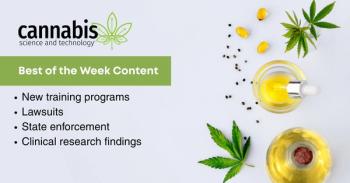
Cannabis Science and Technology
- September/October 2018
- Volume 1
- Issue 3
Welcome to Cannabis Analysis

In this first installment of the "Cannabis Analysis" column, the author introduces himself and the goals for the column.
In this first installment, the author introduces himself and the goals for the column, including the importance of establishing chemical analysis in the cannabis industry, helping those new to chemical analysis with easy to understand explanations of important concepts, and serving as a repository for new and interesting developments in cannabis analysis for those working in the field.
I am thrilled to be given the opportunity by the editors of Cannabis Science and Technology magazine to write this regular column for them and for you. The purpose of this column, entitled “Cannabis Analysis,” is to discuss analytical chemistry as it pertains to the cannabis industry. Our industry makes products that people use for recreational and medicinal purposes, similar to the food, beverage, and pharmaceutical industries. In those industries chemical analysis plays an important part in insuring the safety, efficacy, and profitability of products. It needs to perform the same role in the cannabis industry. One of my goals for this column is help analytical chemistry serve that need.
Because of the history of illegality of cannabis and cannabis products, analytical chemists did not become extensively involved in this industry until recently. This means there may be people in the cannabis industry who perform chemical analyses or interpret chemical analysis results who might not have a technical background and might find themselves struggling as a result. This column is for you. I intend to explain the basics of analytical chemistry as it applies to cannabis. My goal then is if a nontechnical person picks up an issue of Cannabis Science and Technology they can read my columns to gain the understanding they need to make sense of the technical content in the rest of the issue.
However, this column is not just for newbies. Seasoned scientists will benefit from reading this column because it will give them a refresher on important basic topics, introduce them to instrumental techniques they might not be familiar with, and become a place to discover new applications.
Who Am I?
What gives me the right to write a column on cannabis analysis? Let me introduce myself. My experience in analytical chemistry goes back decades. I earned my PhD in physical chemistry from Dartmouth College, and my thesis research involved fundamental research using infrared (IR) spectroscopy. I have worked at several different companies, including instrument companies, as a research scientist and applications chemist. I continued my work in IR spectroscopy, but also broadened my scope by becoming familiar with other types of spectroscopy and the many and varied types of chromatography. For the largest part of my career, I ran an analytical chemistry training and consulting business. I have published a number of peer-reviewed scientific articles, and written three books on analytical chemistry (1–3). I am also an experienced scientific columnist. For several years now I have written a regular feature in Cannabis Science and Technology’s sister publication Spectroscopy magazine called “Infrared Spectral Interpretation Workshop.” If you want to learn how to interpret IR spectra, that column is a good place to start.
My experience in the field of cannabis analysis is more recent, but no less in depth. Shortly after recreational marijuana became legal in Colorado a colleague of mine asked, “Hey Brian, can you use mid-infrared spectroscopy to determine THC in buds?” It took awhile for me to figure it out, but the answer is yes (4). Since then I have been focused on the application of mid-infrared spectroscopy to the analysis of cannabis-containing materials and have found that it can determine cannabinoid and terpene profiles in cannabis bud, trim, oils, extracts, shatter, resin, rosin, wax, sugar, hashish, and kief (5–8). To commercialize my discoveries, I founded and am the Chief Technical Officer of Big Sur Scientific, manufacturers of the BSS 2000 cannabis analyzer. It is a general purpose quantitative mid-infrared spectrometer of unique design that is small and portable.
As you can see, my degree, background, and experience in analytical chemistry, combined with my research in cannabis analysis, make me a good candidate to write this column.
Cannabis is Medicine . . . Test it Like Medicine!
We might not want to think of it this way, but cannabis businesses are in the chemical processing industry. We can draw the analogy to whiskey making. Barley is grown and bred to have a certain chemical composition, is harvested, ground up, and processed via the chemical reaction of fermentation. This processed crop is then distilled to give us the fluid that is bottled and purchased by consumers. Now technically whiskey making is part of the food and beverage industry, but there is chemistry and chemical analysis involved every step of the way.
What I just described is similar to how a cannabis distillate is made. A crop is grown, cannabis, to have a certain chemical composition, in this case a specific cannabinoid or terpene profile. The crop is harvested, ground up, and extracted with a solvent to make an oil. This oil can then be distilled to make a cannabis distillate. Chemistry and chemical operations are present throughout this process.
With the U.S. Food and Drug Administration (FDA) finally on record (9) that a cannabinoid (cannabidiol [CBD]) has a legitimate medical use, even the harshest skeptics must now admit that medicinal cannabis is real. That means the cannabis industry is not only a chemical processing industry, but we are in the business of making medicine; that is, we are in the pharmaceutical business. Since cannabis is medicine it should be tested like medicine! Which means we as an industry have a lot to learn from the pharmaceutical industry in terms of how to process and test medicines.
Drug companies practice what I call “cradle-to-grave” chemical analysis. Raw materials coming in the door are analyzed for identity, potency, and purity. At all points during the synthesis, blending, and processing of medicines measurements are made to ensure process quality, optimization, and product quality. Final product is tested before it goes out the door to be sure it meets specifications and meets the legal requirement that the medicine is safe, effective, and labeled properly for its intended use.
I believe that the cannabis industry needs to adopt a cradle-to-grave testing model like the pharmaceutical industry for several reasons. First, we have a moral obligation to make sure cannabis medicines are safe and effective, which can only be done through testing. Second, to increase the legality of cannabis the industry must do all it can in its power to protect the health and safety of our customers. Cradle-to-grave testing not only helps ensure health and safety, but will help us make our case for increased legalization. Third, we have a legal obligation to test our products. The legal requirements for testing may vary by jurisdiction, but the arrow of time in my opinion is pointing toward increased regulation in all jurisdictions. The industry might as well be ahead of the curve by performing increased testing now. Finally, it makes economic sense. The pharmaceutical industry is required to test by the FDA, but it performs many more tests than required because it helps increase their profitability. Analytical chemistry helps them not pay for inferior material, optimize processes while minimizing cost and risk, and avoid lawsuits by making sure the final product meets label claims and is not harmful.
It has been my observation that in many cannabis businesses the only time testing is done is on the final product. How can you make a safe and effective medicine, comport with regulations, and increase your profitability if you don’t understand what goes into your process, what your process does chemically, and monitor and control that process? You can’t. Thus, in this column I will be a passionate advocate for increased use of chemical analysis in the cannabis industry (stepping off the soapbox now).
Summary
In conclusion then, this column will serve multiple purposes. It will introduce the basics of analytical chemistry to those new to the field, it will give analytical chemists the opportunity to refresh and renew their knowledge, and it will advocate for increased use of chemical analysis in the cannabis industry. I look forward to having many of you as regular readers.
References:
- B.C. Smith, Fundamentals of Fourier Transform Infrared Spectroscopy (CRC Press, Boca Raton, Florida, 2011).
- B.C. Smith, Infrared Spectral Interpretation: A Systematic Approach (CRC Press, Boca Raton, Florida, 1998).
- B.C. Smith, Quantitative Spectroscopy: Theory and Practice (Elsevier, Boston, Massachusetts, 2002).
- B.C. Smith, M.A. Lewis, and J. Mendez, “Optimization of Cannabis Grows Using Fourier Transform Mid-Infrared Spectroscopy,” PerkinElmer Inc. Application Note, Waltham, Massachusetts, 2016.
- B.C. Smith, Terpenes & Testing Magazine, Nov/Dec(6), 48–51 (2017).
- B.C. Smith, Terpenes & Testing Magazine,Jan/Feb(7), 34–40 (2018).
- B.C. Smith and J. Strull, “Determination of Cannabinoid and Terpene Profiles in Cannabis Bud and Trim by Mid-Infrared Spectroscopy,” Cannabis Science and Technology, in preparation.
- Big Sur Scientific website:
www.bigsurscientific.com . - United Stated Food and Drug Association website:
https://www.fda.gov/newsevents/newsroom/pressannouncements/ucm611046.htm .
Brian C. Smith, PhD, is Founder, CEO, and Chief Technical Officer of Big Sur Scientific in Capitola, California. Dr. Smith has more than 40 years of experience as an industrial analytical chemist having worked for such companies as Xerox, IBM, Waters Associates, and Princeton Instruments. For 20 years he ran Spectros Associates, an analytical chemistry training and consulting firm where he taught thousands of people around the world how to improve their chemical analyses. Dr. Smith has written three books on infrared spectroscopy, and earned his PhD in physical chemistry from Dartmouth College.
How to Cite This Article
B.C. Smith, Cannabis Science and Technology1(3), 10-12 (2018).
Articles in this issue
over 7 years ago
Cannabis Uncertaintyover 7 years ago
The Cannabis Science Conference Grows to New LevelsNewsletter
Unlock the latest breakthroughs in cannabis science—subscribe now to get expert insights, research, and industry updates delivered to your inbox.


